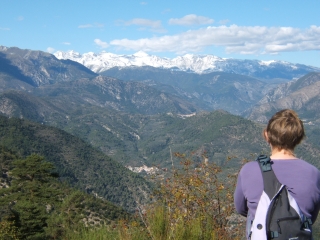Tonight will be our last night in the marina boatyard on board Cirrus before we depart for our winter home. Sleep might not, however, come easily as we are currently in the grip of the fiercest storm in our experience here. Gusts are whipping across the island and even tucked in behind the raised bank in a corner of the yard our boat is shaking and vibrating beneath us. Our mast pokes up above the bank into the full strength of the wind making the rigging howl and whine, the pitch varying with the wind strength and in the squalls there is a low humming noise as well, as if the mast is being played like a violin string. Leaves torn from the young trees above us flash past our windows, smaller broken pieces of debris settling on our wet deck briefly then flying off again.
As I write the sun shines brightly from a patch of blue sky, as if defying the storm. But every few minutes a rain squall drops from the racing clouds, water accelerates in the fast-moving air and thrashes against us, penetrating every weakness, invading everything it can. All day yesterday the barometer needle swung anticlockwise as the pressure dropped steadily. By evening the wind had reached gale force, the noise rising with it, disturbing our sleep. This morning the air pressure had reached its lowest point and started to climb back up, the barometer needle now moving rapidly. The wind continued to increase in strength; 75 mph gusts are now flashing past us, diving down the slope to the sea behind us then hurtling across Oban Bay, whipping up spray which is driven away into the town. Little is moving. No ferries are leaving port. The population is hunkered down for the duration.
We count our blessings that Cirrus was lifted out some days ago. The marina, still full of yachts, is sheltered by the island but masts are swaying about wildly just the same. We think we are through the worst now; if the forecast is right, the wind will diminish overnight so our journey across to the mainland tomorrow is not likely to be affected.
A boatyard is a strange place to be living, hardly to be recommended. We have mains electrical power here but for the toilet and showers we have to cross the open yard, negotiating puddles and other debris. There are few lights and at night you forget the torch at your peril. Even with this there are hazards, like the sheepdog from the nearby farm who wandered into the yard and tried to round up Kate on her way back to the boat the other night, getting quite cross and nipping at her heels when she would not stay in one place.
On our last brief walk around the island several days ago we found this deserted beach where we added our footprints in the sand to those of the otters who live here. A truly magical place this, the pebbles carried here from a thousand different headlands all with stories to tell of their journeys.
So today we are packing - one large suitcase and one large shopping trolley - ready for our travels. Somehow, possibly with the assistance of a few ropes, we'll manoeuvre our luggage from deck to ground then across the yard and along the pontoon to the ferry. For the next week we have a complicated schedule, a minor surgical operation, and many miles of our own journeying to undertake.









